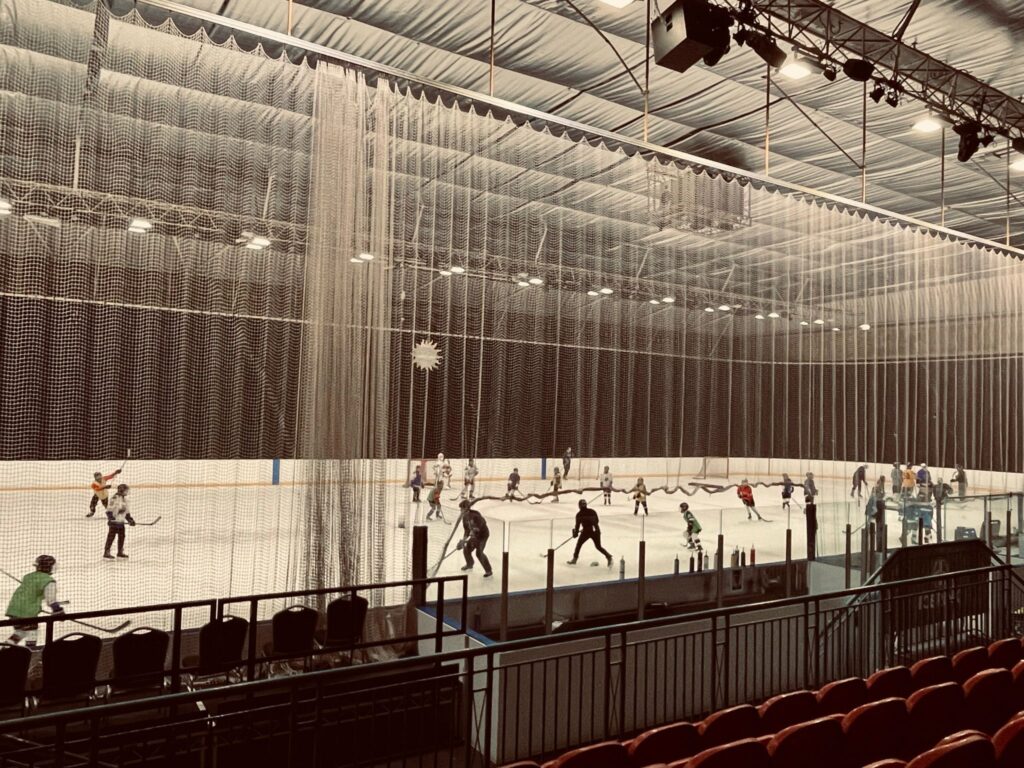I’m a hockey mom. I spend a good chunk of my week around ice rinks, cheering on my son and chatting with other parents who, like me, are constantly trying to juggle school schedules, training sessions, homework, and the occasional meltdown over French vocabulary. And let me tell you: you don’t need to be aiming for Olympic gold to feel the squeeze. Even three regular sports sessions a week can stretch a family’s routine to the limit.
Caught Between Timetables and Timelines
Many families feel the pressure: always one test behind, one training late, one step too slow. For the kids, it can feel like they’re constantly playing catch-up in class and on the field. And for parents, it’s a daily dance of logistics, worry, and encouragement.
The fear of underperforming in either school or sport is real. Kids want to do well in both. Parents want to support them in both. But when expectations pile up and time runs out, it’s easy to feel like someone – or something – is being let down.
Support That Fits
So how can kids stay on track academically while enjoying the benefits of sport? How can parents and teachers support this balancing act without stress levels going through the roof? That’s exactly where learning strategies, flexible support, and a shift in mindset can make all the difference.
Earlier this year, I visited the OYM College in Switzerland , a school for elite athletes that combines professional-level sports with flexible, self-organised learning. It’s an inspiring model of what’s possible when students are supported not just as learners, but as individuals with multiple talents and passions. I wrote about it for the journal “Bildung Schweiz”. You can find the full article here .
In this post, I’ll share what I’ve learned through personal experience as a teacher, mother, and founder of enduri, and what research tells us about the connection between physical activity and cognitive development. And I’ll show you how enduri helps learners, parents and teachers navigate this balancing act.
Sports Boost More Than Muscles
Why Physical Activity Supports Cognitive Growth
Studies show that regular physical activity doesn’t just improve coordination – it also enhances concentration, memory, and mood. Kids who are active tend to perform better academically because exercise increases blood flow to the brain and reduces stress levels [1].
Movement also has a direct link to mental health. Walking, for example, has been shown to reduce anxiety and depressive symptoms and to improve overall emotional resilience in children and adolescents [5]. Sports can serve as a natural mood stabiliser, helping kids regulate emotions and manage stress more effectively [6].
Additionally, participation in structured sports helps children learn essential life skills such as following rules, interpreting feedback, and respecting authority. These skills translate into the classroom, where learners are expected to follow instructions, meet expectations, and collaborate with peers and adults [7].
The Confidence Factor
Being part of a team, improving in a sport, or simply mastering a new move boosts self-esteem. That confidence often spills over into the classroom, especially when students feel supported and recognised for both their academic and athletic efforts [2].
The Pressure of Packed Days
Even “Normal” Sports Schedules Add Up
Three training sessions a week. One match on the weekend. Maybe a music class thrown in — plus the school’s annual fundraising event and the local teen empowerment group. Suddenly, a child’s week looks more like a busy adult’s. And that doesn’t leave much space for homework or downtime. Let’s be honest: exhausted kids don’t learn well.
Parents Become Project Managers
As parents, we’re often the ones juggling the calendar (don’t forget the birthday parties), packing the bags (or at least pretending we checked them), prepping the snacks (yes, yes, only “healthy” stuff!), and reminding our kids what still needs to get done after practice (no, ChatGPT is not doing your homework). It’s a full-time job disguised as parenting. And when school expectations leave no room for flexibility, it’s not just the kids who feel the pressure. They say it takes a village to raise a child. More likely? It takes a village and a top-tier coordination company.

Flexibility doesn’t mean “laissez-faire” or doing homework on the floor of the changing room. It means offering alternative learning structures: varied formats, time-shifted deadlines, and access to tailored strategies .
Learning Needs Strategy, Not Just Time
Learning as a Process, Not a Race
Learning isn’t about stuffing in content – it’s about understanding, making connections, and building knowledge over time. Just like in sport, repetition and routine build strength. It’s hard work, sometimes exhausting, and without endurance, there’s no winning the game. Having the right strategies in place is a game changer. A child who knows how to structure their learning sessions effectively will make the most of the limited time they have.
Self-Guided Doesn’t Mean Alone
At enduri, we believe in independent learning—but that doesn’t mean doing it all alone. Kids need learning strategies they can rely on: how to organise a learning unit, how to prioritise tasks, or how to reflect after a study session. These are skills that can be taught – and practiced.
Being able to count on learning strategies that truly work is like being a goalkeeper who trusts their defence. It takes practice, time, hard work, communication, coaching – and yes, probably a few disappointments and misunderstandings along the way. But once it clicks – once things start to flow and effort meets support – you can rely on each other. That’s when real progress happens: this is learning – in sport, in school, and in life.
A great example is what I observed at OYM College. Their students, many of them young ice hockey players, use flexible digital learning tools and are supported by learning coaches who help them take charge of their learning. It’s a system that respects both the demands of sport and the needs of individual learning. That kind of structure is exactly what we aim to offer with enduri.
How enduri Supports Young Learners
One Strategy Does Not Fit All
Every child has different needs and strengths. Some are visual learners, others more haptic or auditory. That’s why enduri offers personalised learning strategies, tailored to how each learner works best. With the Learner ID, kids discover their individual learning profile – what helps them focus, remember, and understand most effectively.
But learning isn’t lightning fast. Real progress takes time. Repeating, reflecting, adapting – it’s a process. That’s why enduri offers the right tools to support that journey: from reflection templates for students to coaching guides for teachers. Because learning isn’t just about speed – it’s about building something that lasts.
Digital Support, Real-World Impact
Progress takes time – and staying motivated and focused can be a real challenge. That’s where enduri comes in: with gamified elements, rewards, leaderboards, motivational notes, and a clear structure, we help learners stay engaged and on track. But enduri also supports the adults in the room – teachers and parents – by offering insights into learning progress, preferences, and patterns. Everyone is part of the same team. And when everyone pulls together, learning becomes a shared success.
What Teachers and Parents Can Do
Create Flexible Frameworks
Let’s be honest: a single tool like enduri—(even if it is a learning game-changer and deserves a place in every school) – can’t transform entire school structures on its own. But what enduri can do is highlight a crucial message: flexibility isn’t a luxury – it’s a necessity.
And no, flexibility doesn’t mean “laissez-faire” or doing homework on the floor of the changing room between two training sessions. It means offering alternative learning structures: varied formats, time-shifted deadlines, and access to tailored strategies that help students make the most of limited time.
Research confirms that flexible learning environments promote greater learner autonomy and reduce dropout risks – especially for students who are trying to balance school with other serious commitments [4]. Adaptive schedules, digital tools, and teacher understanding aren’t just helpful – they’re essential. Because often, it’s not a lack of ability that causes learners to fall behind, but simply a schedule that doesn’t fit.
Be a Coach, Not a Rescuer
Parents don’t need to have all the answers. But they can help their children reflect, plan, and find their own solutions. Still, getting real insight into how your child learns? That’s not easy. Who tells you these things? Has a teacher ever pulled you aside to say, “By the way, your son is doing an amazing job organising his learning”? Probably not.
That’s why this shift—from helping with content to supporting the learning process – matters so much. And it’s exactly what enduri is built to support. We help make learning strategies visible, accessible, and part of everyday conversations between learners, teachers, and parents. Welcome enduri to your support team. www.enduri.org
* For all ice hockey aficionados: The picture shows the ice rink at Alexandra Palace in London, fondly known as Ally Pally. A unique detail: the crocheted protective curtain instead of plexiglass. Players and parents had to carefully pull it across before every practice session. But those days are over: Since 2024, Ally Pally now also has proper glass panels.
Sources:
1 Donnelly, J. E., et al. (2016). Physical Activity, Fitness, Cognitive Function, and Academic Achievement in Children. Pediatrics.
https://pubmed.ncbi.nlm.nih.gov/27182986/
2 Eime, R. M., et al. (2013). A systematic review of the psychological and social benefits of participation in sport for children and adolescents. International Journal of Behavioral Nutrition and Physical Activity.
https://ijbnpa.biomedcentral.com/articles/10.1186/1479-5868-10-98
3 Wüthrich, C. (2025). Balancing between sports and school. https://wuethrich.eu/en/2025/03/26/balancing-act-between-elite-sports-and-school/
4 Fotiadou, A., Angelaki, C., & Mavroidis, I. (2017). Learner Autonomy as a Factor of the Learning Process in Distance Education. European Journal of Open, Distance and e-Learning.
https://files.eric.ed.gov/fulltext/EJ1187831.pdf
5 Biddle, S. J. H., & Asare, M. (2011). Physical activity and mental health in children and adolescents: A review of reviews. British Journal of Sports Medicine.
https://bjsm.bmj.com/content/45/11/886
6 Lubans, D. R., et al. (2012). A systematic review of the impact of physical activity programmes on social and emotional well-being in at-risk youth. Child and Adolescent Mental Health.
https://acamh.onlinelibrary.wiley.com/doi/abs/10.1111/j.1475-3588.2011.00623.x
7 Holt, N. L., et al. (2017). Positive Youth Development through Sport: A Review. Revista de Psicología del Deporte.
https://www.redalyc.org/pdf/3111/311126249009.pdf

